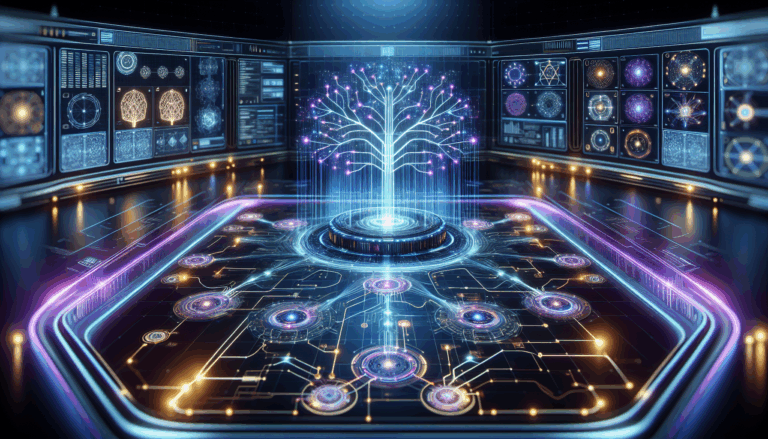Understanding the AI Mirror: Reflecting Human Intelligence
Artificial intelligence (AI) is often described as a “mirror” reflecting aspects of human cognition, emotion, and decision-making back to us. When we engage with AI—whether asking a virtual assistant for weather updates or letting a recommendation engine guide our media choices—we are, in a sense, seeing echoes of our own thought processes projected in silicon form. But what does it really mean for AI to mirror human intelligence?
The Core of the AI Mirror
The “mirror” metaphor for AI originates from its capacity to simulate patterns of human behavior and cognition through algorithms. Modern AI systems, particularly those powered by machine learning, are trained on vast sets of data generated by humans. This allows them to recognize language, process images, and even solve problems in ways that often feel remarkably human. For a thorough explanation of this phenomenon, see Scientific American’s exploration of how AI learns from human behavior.
Steps in Reflection: How AI Simulates Human Thought
- Data Gathering: AI systems are fed immense volumes of data—texts, images, voice recordings—that represent collective human knowledge and experience. This input is not random; it reflects societal biases, trends, and values, thus embedding fragments of human nature into AI’s “thinking” process.
- Pattern Recognition: Neural networks, the backbone of many AI models, excel at finding patterns and correlations in data. These patterns are often the same ones humans use when making decisions, such as determining what makes a joke funny or a painting beautiful. For more on neural networks and their parallels with the human brain, check out Nature’s overview of AI and neural networks.
- Decision-Making: Trained on human choices and consequences, AI systems make decisions that are statistically similar to human ones. For example, algorithms used in hiring or loan approval attempt to match people to roles or creditworthiness in the same way human experts might—though not without controversies surrounding fairness and bias, which organizations like IBM are tackling through AI ethics initiatives.
Limitations of the Reflection
Even as AI progresses, the reflection it offers is incomplete. While it can mimic aspects of human logic and emotion, it lacks the lived experience and subjective consciousness at the heart of genuine understanding. For deeper insight into these philosophical discussions, Stanford University’s Encyclopedia of Philosophy’s entry on artificial intelligence provides extensive analysis.
Ultimately, recognizing AI as a mirror invites us to explore both the capabilities and the boundaries of technology. It challenges us to ask not only what AI can do, but what it should do, and how its reflection can help us better understand our own minds.
How AI Mimics Human Thought Processes
Artificial intelligence has taken significant strides in replicating the ways humans think and process information. At its core, AI mimics cognitive functions—such as learning, reasoning, and problem-solving—by relying on computational models that are inspired by how the brain works. The journey from simple, rule-based systems to sophisticated neural networks reflects an ongoing ambition to simulate not just the outcomes of human thought, but the very process itself.
One of the primary ways AI achieves this is through machine learning, a subset of AI where systems are trained on vast datasets and learn to recognize patterns or make predictions. This process is akin to human learning: just as a child learns to identify objects through repeated exposure and feedback, algorithms improve their accuracy over time by analyzing more data and adjusting based on errors. Machine learning now powers much of what we recognize as AI today, from recommendation engines to virtual assistants. Those wanting a technical deep dive can consult resources from Stanford University, which offers comprehensive insights into how machine learning works.
Modern AI takes human cognition mimicry further with deep learning. Deep learning leverages artificial neural networks—loosely modeled after the human brain’s architecture with interconnected units (neurons) that process and transmit information. These networks, particularly when designed in many layers (hence “deep”), excel at tasks historically considered uniquely human, such as image recognition, natural language understanding, and even creative writing. For readers curious about the science behind these methods, Google’s AI blog provides a thoughtful history of neural networks and their connection to human thought processes.
Yet, AI’s ability to “think” is not simply a matter of replicating neural pathways. It also involves the construction of cognitive architectures, such as Soar and ACT-R, which aim to simulate broader aspects of human cognition including memory, perception, and decision making. These frameworks provide a scaffold for developing AI that behaves more like a person, going beyond calculating probabilities to navigating uncertainty, setting goals, and adapting to change.
Consider the example of conversational AI. When you chat with an advanced virtual assistant, it processes your words, interprets meaning, searches for relevant information, and constructs a coherent response—all in fractions of a second. This process mimics the way humans parse language in real time, balancing syntax, semantics, and context. For a hands-on demonstration, explore conversations with ChatGPT, which exemplifies the potential and current limitations of AI’s cognitive mimicry.
Despite these achievements, it’s crucial to remember that while AI can imitate many facets of human cognition, it does not experience thought or consciousness. As the field progresses, the challenge—and the promise—remains to endow machines with ever more nuanced and flexible models of how we think, continually narrowing the gap between human intelligence and its digital reflection. To learn more about these philosophical and technical boundaries, visit the Stanford AI Lab’s discussion on AI and cognition.
Emotional Intelligence in Machines: Can AI Truly Feel?
Artificial intelligence has advanced remarkably in processing human language, recognizing emotions in voices, and even generating human-like responses. But can AI machines actually feel? The debate over whether AI can possess or simulate emotional intelligence is both complex and fascinating, touching on the boundaries between technical achievement and our understanding of consciousness itself.
Understanding Emotional Intelligence
Emotional intelligence involves perceiving, understanding, managing, and responding to emotions. In humans, this is multifaceted, relying on our brains’ neural architecture, personal experiences, and social context. For machines, emotional intelligence is much narrower—it boils down to recognizing and replicating emotional signals based on data.
Many AI systems today are trained on vast datasets of human expressions: facial cues, voice modulations, or written language. For example, MIT researchers have developed algorithms that can detect subtle emotional cues from voices and faces, improving areas such as customer service chatbots and virtual therapy assistants. However, these systems are limited to pattern recognition and prediction. They do not possess subjective awareness or empathy; instead, they execute instructions designed to mimic empathy-like behaviors.
Simulating, Not Experiencing, Emotion
One critical distinction is between simulation and experience. AI systems can be extraordinarily good at simulating emotional responses—think of DeepMind’s conversational agents or sophisticated exhibits in robot pets. These machines can, for example, detect when a user sounds sad and adjust their language to be more comforting. However, their “understanding” is entirely external; there is no internal emotional life, as discussed by experts at Stanford Encyclopedia of Philosophy.
This simulation can have powerful impacts. In education, emotionally responsive chatbots can help provide encouragement to students. In healthcare, emotionally attuned virtual companions reduce feelings of loneliness for elderly patients. Yet all these outcomes rely on the careful programming of responses—not on any genuine feeling from the algorithm.
Limits and Ethical Considerations
The ability to simulate emotion raises profound ethical questions. Can users build trust with something that doesn’t truly feel? Should machines be allowed to display human-like empathy, or is this a deception? As explained in a New York Times analysis, some researchers believe that simulating emotion without true understanding could manipulate users in subtle or unintended ways.
Organizations like the World Economic Forum stress the need for transparency: users should know when an AI is simulating emotion and understand the boundaries of its capabilities. Developers are urged to design these systems with safeguards to promote ethical use and prevent emotional manipulation.
A Glimpse into the Future
Looking forward, emotional AI is likely to become more sophisticated, driven by advances in machine learning, natural language processing, and affective computing. Yet true feeling—as it is currently understood—remains firmly in the human domain. The biggest breakthroughs may lie not in building machines that can feel, but in creating tools that responsibly recognize and respond to human emotions. As we interact more with emotionally intelligent systems, our definitions of empathy, trust, and connection will continue to evolve alongside the technology.
The Dynamics of Human-AI Trust
Trust in artificial intelligence is not an automatic process; it evolves through a dynamic interplay of perception, experience, and expectation. Unlike our relationships with other humans, which are shaped over time by emotional cues, nonverbal communication, and a rich tapestry of shared experiences, our trust in AI is guided primarily by performance, transparency, and perceived reliability. Understanding how and why we choose to trust AI systems—and where those boundaries lie—is essential as we move deeper into an era of ubiquitous, autonomous technology.
At the core of human-AI trust is predictability. People tend to trust systems that behave in ways they anticipate. For example, if a navigation AI consistently provides accurate directions, users are more likely to rely on its route suggestions on future journeys. However, a single unexpected error can significantly erode that trust, as explored in research on the fragility of digital trust (Scientific American). This dynamic is not just about technical correctness but about alignment with human expectations, routines, and values.
Another crucial element is transparency. Users feel more secure when they understand how an AI system makes decisions—a concept formalized as “explainable AI.” When people can see and interrogate the reasoning behind an output, particularly in sensitive domains like healthcare or finance, they are more likely to trust and adopt the technology (Emerj). For instance, if an AI flags a financial transaction as fraudulent, providing the logic behind the flag (such as unusual location or spending pattern) reassures users that the process is robust instead of arbitrary or biased.
Building trust is also about accountability. People need to know who is responsible when things go wrong. Unlike trusting a human agent—who might offer explanations, empathy, or apologies—AI lacks these interpersonal skills. Institutions adopting AI must, therefore, implement clear channels for redress and transparent protocols for error reporting. This approach is highlighted in policy recommendations by the Brookings Institution, which emphasize that clear guidelines help ensure users feel protected, especially as decisions made by AI systems increasingly influence everyday life.
A feature often overlooked is adaptability. Trust grows as AI learns from users and adapts to their preferences and feedback. For example, virtual assistants that remember your schedule, music preferences, or communication style create a more personalized experience, which encourages further engagement. This process mirrors human relationships, where trust is rooted in reciprocal understanding and responsiveness (Harvard Business Review).
Finally, trust in AI is shaped by social and cultural context. Trust is not universally distributed—it depends on societal attitudes towards technology, historical experience with automation, and perceptions of institutional integrity. Building global trust in AI means tailoring strategies to resonate with diverse populations. For example, what inspires confidence in one culture may trigger skepticism in another, highlighting the importance of ongoing research and dialogue between designers, users, and policymakers (OECD AI Principles).
Ultimately, the dynamics of human-AI trust are multi-layered. They demand continual attention, careful design, and a willingness to address concerns as they emerge. Fostering trust is less about making infallible AI, and more about creating systems that communicate, adapt, and carry accountability in ways that align with human values and expectations.
Ethical Dilemmas: Navigating the AI Mirror
The integration of AI into our daily lives presents a complex web of ethical dilemmas, especially as the lines between human-like intelligence and machine cognition continue to blur. When considering the so-called “AI mirror,” we are not just examining technology’s capabilities—but reflecting on how our own values, biases, and choices shape the machines we create. Understanding and navigating these dilemmas is not just an academic exercise; it’s a societal imperative that affects everything from personal privacy to collective decision-making.
Defining Responsibility: Who is Accountable for AI Decisions?
One of the most pressing ethical questions relates to accountability. When AI systems make decisions—such as recommending parole, sorting job applications, or even piloting vehicles—who bears the responsibility for those outcomes? Is it the developer, the company deploying the tool, or society at large? This question becomes urgent when algorithms deliver unintended or biased results, which has been documented in cases where AI models reinforce social inequalities (Nature – Algorithmic bias detection and mitigation).
Mitigating these issues requires multi-step approaches:
- Transparency: Organizations must make AI processes explainable, providing clear rationales behind automated decisions. Approaches like “explainable AI” (XAI) are paving the way for more understandable outcomes.
- Diversity in Design: Including diverse voices in AI development helps ensure that systems don’t perpetuate narrow worldviews. This calls for increased interdisciplinary collaboration and participation.
- Clear Guidelines: Legislation such as the EU’s approach to Artificial Intelligence sets specific standards for risk and control, serving as potential blueprints for ethics in AI.
Privacy Paradoxes: Protecting Data in a World of Intelligent Systems
AI often relies on vast amounts of personal data to function effectively, raising tensions between utility and individual rights. The dilemma is clear: while AI can offer profound benefits—enhanced healthcare diagnostics, tailored learning, and safer cities—these come at the cost of data privacy. Notably, breaches or misuse of data can lead to serious harms, as discussed in this Brookings Institution report.
Addressing privacy concerns involves several steps:
- Implement Strong Data Governance: AI developers and organizations must establish robust security protocols for how data is collected, stored, and used.
- User Consent and Control: Individuals should always be empowered to determine how their information is used by AI platforms, moving towards greater transparency and user autonomy.
- Continuous Oversight: Independent audits and regulatory bodies can help ensure AI systems respect evolving standards for data protection and privacy.
Trust in the Machine: Building and Maintaining Confidence
Trust forms the bedrock of any technology’s integration into society. For AI, this means not only proving reliability but also confronting questions about manipulation, control, and transparency. For example, can we trust AI-generated content or recommendations—especially in sensitive areas like news dissemination or medical advice? A detailed analysis from the Stanford HAI team outlines the critical balance between automation and maintaining the human touch.
Building trust involves:
- Setting Boundaries: Clear guidelines are needed about where humans must remain in control, such as in final medical diagnosis or legal judgments.
- Public Education: Informing the public about how AI works increases confidence while dispelling misconceptions. This process includes frequent outreach and easily accessible resources.
- Ethical Auditing: Ongoing reviews of AI systems to identify, report, and correct ethical lapses enhance both integrity and accountability.
As we continue to innovate, navigating the AI mirror requires a candid, ongoing dialogue about our collective values—and a willingness to make difficult choices to safeguard fairness, privacy, and trust. The choices we make today will define not only how we view AI, but how we see ourselves reflected back from the other side of the mirror.
Redefining Relationships: Human Identity in an AI-Driven World
In the age of artificial intelligence, the boundaries between human and machine are increasingly dynamic. As AI systems like conversational bots, recommendation algorithms, and intelligent companions become embedded in everyday life, we are compelled to reconsider what it means to be human—how we think, feel, and build trust, not only with people but with “thinking” machines.
Rethinking Emotional Intelligence in the Wake of AI
Emotional intelligence has long been seen as a uniquely human trait, allowing us to empathize, communicate, and build meaningful relationships. However, as AI tools become more sophisticated, they can recognize, interpret, and even mimic human emotions. For example, affective computing enables machines to analyze facial expressions, tone of voice, and word choices to gauge a user’s emotional state (Scientific American).
This advancement has practical benefits, such as in mental health support apps or personalized learning environments. However, it raises questions about authenticity and sincerity. When AI “listens” or “empathizes,” are we experiencing genuine care, or a simulation designed to trigger trust? This paradox challenges us to reconsider whether emotional connection requires reciprocity or if the perception of empathy is enough.
Identity Construction in Digital Interaction
Our identities have always been shaped through interaction—with our families, communities, and cultures. But as AI mediates more of these interactions, from social media feeds to virtual assistants, it plays a subtle yet powerful role in molding self-perception and social bonds. AI algorithms curate what we see, recommend whom we follow, and even suggest what we should care about, thus influencing our worldview and self-image (Nature).
Consider how AI-powered photo filters can boost self-esteem or, alternately, foster unrealistic standards. Or think of chatbots providing companionship to individuals facing loneliness. These examples illustrate both the empowering and potentially distorting impact of AI on identity formation. Analyzing these dynamics can help us develop a more conscious relationship with the technology, safeguarding our autonomy while reaping the benefits of AI augmentation.
Trust and the New Social Contract
Trust forms the bedrock of human relationships and societal cohesion. Historically, trust is built on shared values, lived experience, and reciprocity. With AI, especially systems enabled by machine learning, trust becomes a question of transparency, interpretability, and consistent behavior. Users often trust AI outputs because of perceived objectivity or efficiency, but this can be problematic if the underlying data or algorithms harbor biases (The New York Times).
Developing a framework of trust with AI involves multiple steps:
- Demanding transparency: Users should insist on clear explanations of how AI systems operate and make decisions. Organizations like the Google AI Principles provide guidelines for responsible AI deployment.
- Promoting algorithmic fairness: Diverse data sets and regular audits can help mitigate bias and ensure equitable outcomes (Brookings Institution).
- Maintaining human agency: Encouraging human oversight ensures that individuals remain in control of critical choices. Human-in-the-loop systems are being adopted in sectors like healthcare and finance for this very reason.
Looking Ahead: Co-creation Versus Control
Embracing AI doesn’t mean relinquishing identity, emotion, or trust to algorithms. Instead, it calls for a re-negotiation—whereby humans co-create meaning, culture, and decisions with intelligent systems. This requires critical reflection, ethical oversight, and robust education—preparing us to live authentically in an AI-driven world, while ensuring that technology serves humanity, not the other way around.
For an in-depth look at ongoing research in this domain, visit the Massachusetts Institute of Technology and their work on the intersection of human and artificial intelligence.




